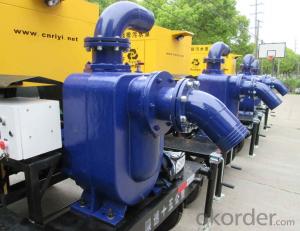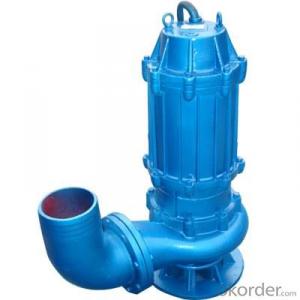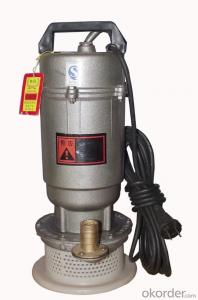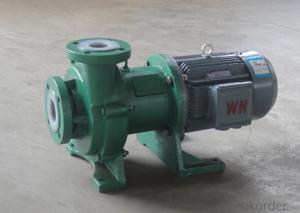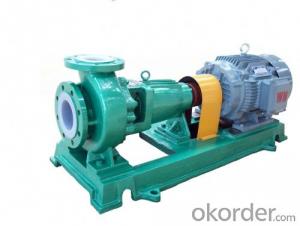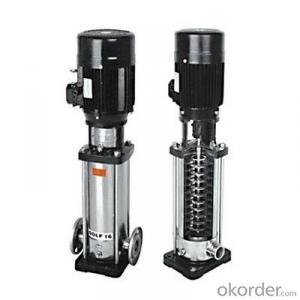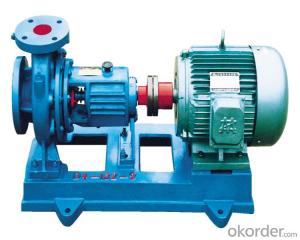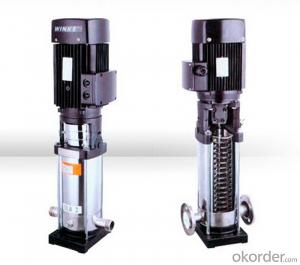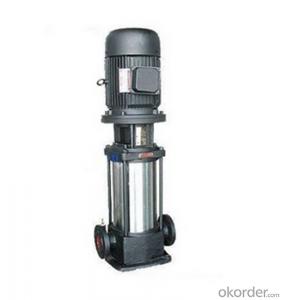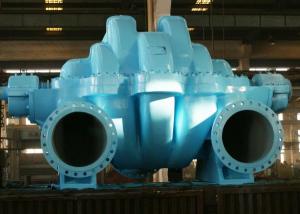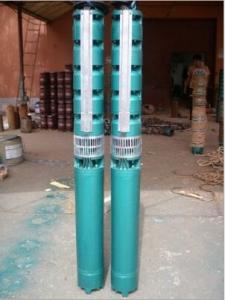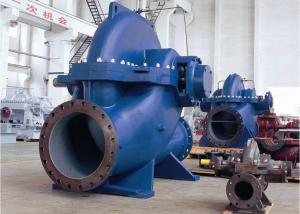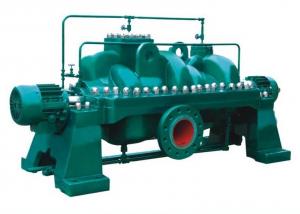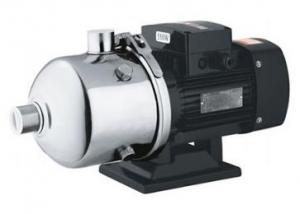Stainless Steel Vertical Multi-stage Centrifugal Pump
- Loading Port:
- China Main Port
- Payment Terms:
- TT OR LC
- Min Order Qty:
- -
- Supply Capability:
- -
OKorder Service Pledge
OKorder Financial Service
You Might Also Like
Application: SMV. SMVN is a kind of non-self-priming vertical multiple-step centrifugal pump. The whole pump is composed of an motor, motor base, pump casing and feet etc. The inlet port and outlet port of the pump are at the same line. All pumps are equipped with free maintenance mechanical seals.
--------------------------------------------------------------------------------
Feature:
--------------------------------------------------------------------------------
OPERATING CONDITIONS
1. Delivery liquid: rarefied, non-inflammable and non-explosive liquid with no solid grain or fiber. Liquid shall not cause any chemical or mechanical damage to pump materials. When the density or viscosity of the delivered liquid is greater than that of water, it is necessary to adopt an electrical motor of correspondingly big power. Whether the pump is applicable for a special liquid or not depends on many factors such as chloride content, PH value, temperature and ingredients of liquid.
2. Liquid temperature: -15oC~103oC
3. Ambient temperature: maximum 40��. When an ambient temperature is over 40oC or the elevation above sea level is over 1000 meters, the cooling effect of the electrical motor will not be good due to the low density of air, and the rated output power of an electrical pump will decrease correspondingly. Therefore, it is necessary to select an electrical motor with higher power.
4. Minimum inlet pressure: the inlet pressure shall be computed in case of following conditions.
High temperature of liquid, flow rate is significantly greater than the rated value, suction lift required for liquid is very big, inlet pipeline is too long; inlet conditions are bad.
5.Motor:squirrel cage induction motors,F Class insulation and in accordance with IP 54.50Hz standard voltage:3Ø/380V.
- Q: I was wondering if there was a device that can pump and cool water. What I am looking for is essentially an aquarium pump that cools the water as it circulates.
- You okorder /
- Q: Rated power of three-phase pump4000W is a three-phase operating pump, the voltage is 380V, how to find the three-phase water pump current, and the formula is what?
- Three phase water pump motor rated power 4000W is the output shaft power, divided by the motor efficiency (general 85%) is the input power, which is often mistaken. The electric power is =4000/0.85=4706WRated current = electric power /1.732x, rated voltage x, power factor =4706/1.732x380x0.8=8.94A (assuming power factor 0.8).The above three answers are all wrong.
- Q: water pump has small leak
- If its an automotive water pump, you need to have it replaced. Because of pump pressures and constant expanding/contracting there is no reliable way to seal the leak. Plus the leak will only get worse. Radiator additives basically clog leaks from the inside, like a bloodclot on a body. But the leak never actually heals and instead the stuff clogs other parts like the inside of the radiator or heater core.
- Q: Cant get the bolt loose fromthe fan that is attached to the water pump in my ford ranger. need to remove bolt in order to remove water pump.
- You need a special tool that grasps and holds the water pump pulley by the four bolts that secure the pulley to the pump, while you loosen the fan by using the correct size of wrench to turn it CLOCKWISE to remove. The hex of the fan clutch is LEFT-HAND threaded on this particular vehicle application. You may need to heat the hex of the nut slightly with an oxy/acetylene torch if too much force is required to crack the hex loose. Once loosened, simply spin it off with your hand by the blade until it is removed. Hope this helps.
- Q: how to change a water pump on a 99 ford tauras?
- Loosen the bolt, swap it with a new pump and tighten the bolt.
- Q: water pump pulley has slight wobble in it. not seeing water yet....is bearing going bad
- either the bearings are going out, or the pulley is bent. either way you should go ahead and change the water pump, they are cheap and if you wait it will be a problem later when you get stranded. good luck
- Q: I just replaced my water pump.fixed.. A week later I've been noticing he might of over filled it because.were the coolant goes.steam comes.out.the little.while plus water.. And.before.I.started my.car I noticed.it was all empty now and my.engine sounds like a mini diesel when it runs.. What's the deal? And I.already filled it up with coolant again
- Anytime you replace your water pump. You should replace the thermostat and gasket. Also check the upper and lower radiator hoses to see if either one of them are collapsed.It wouldn't hurt to replace the radiator cap.
- Q: do you trust the bran?
- We dont install autozone anything at our shop. I would say no.
- Q: Can I use Ultra Blue gasket maker on a water pump? The packaging is not labeled high heat.
- Yes, but you have to let the gasket maker cure for at least 24 hours. After you have driven it for a couple days, be sure to re-tighten the flange bolts, as the gasket maker will shrink with heat, causing possible leakage. Good Luck !
- Q: my 98 expedition keeps over heating, i replaced the water pump, thermostat,coolant. it will be fine one minute then it overheats. weather im on the road or sitting at a light. i also replaced the fan clutch. thanks!
- If you have the 5.4L motor it will have a plastic intake manifold. Look at the front. There is an aluminum crossover pipe attached to the front on the top. Those are famous for leaking aroung where the intake meets the head and where the aluminum and plastic meet. You may need a flashlight and a small inspection mirror to check all the way around. Also if the valley or apace between the heads has coolant sitting in it that's a good bet you have a leaking crossover or a head temp sensor leaking. The head temp sensors are located at the back of the heads. The other common spot for coolant to leak is the heater hoses be sure to check at all the fittings and make sure they haven't come apart up by the firewall. One last thing to check is the belt around the water pump pulley. It is easy to put it on so the water pump spins the wrong way. Common mistake. Lastly if the manifold IS leaking do NOT attempt to do this if you do not have a top notch torque wrench!!! You can very easily strip the bolts or holes that are in the heads. If you are not sure take it to a good technician. Dorman makes a good replacement manifold for about 200-300 bucks. The gaskets are made onto it. I have had no issues with that one leaking. Also do not try to relpace just the crossover... I know that it has bolts and they sell gaskets but it will leak. If the manifold needs to come off it is also a great time to change the plugs. They will be super easy at that point, be sure to use new Injector o-rings too. Hope that helps. Jim
Send your message to us
Stainless Steel Vertical Multi-stage Centrifugal Pump
- Loading Port:
- China Main Port
- Payment Terms:
- TT OR LC
- Min Order Qty:
- -
- Supply Capability:
- -
OKorder Service Pledge
OKorder Financial Service
Similar products
Hot products
Hot Searches
Related keywords




